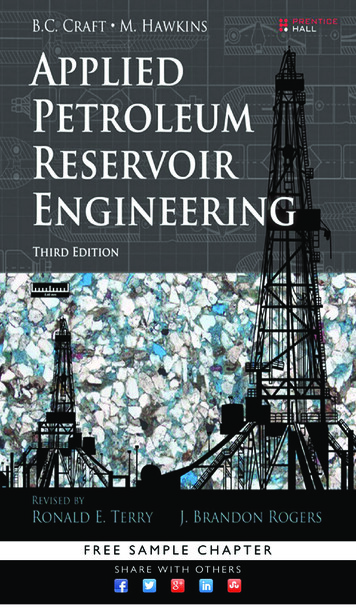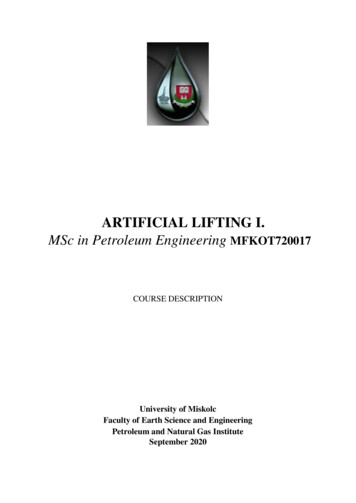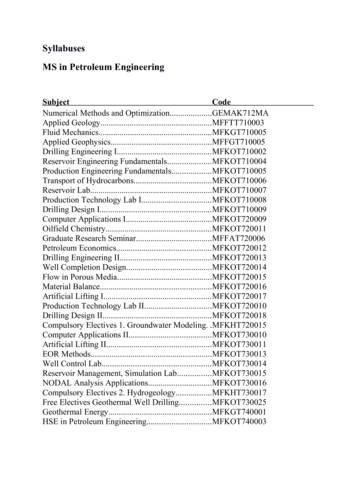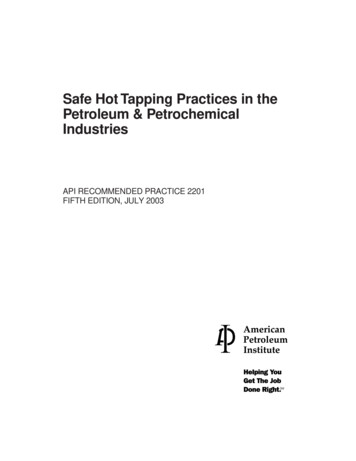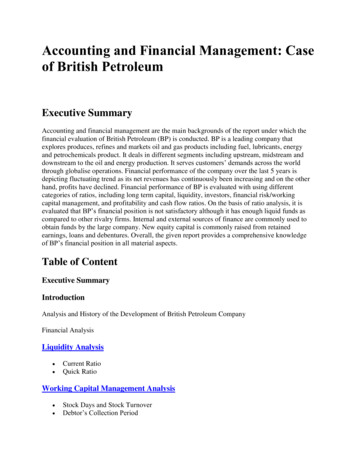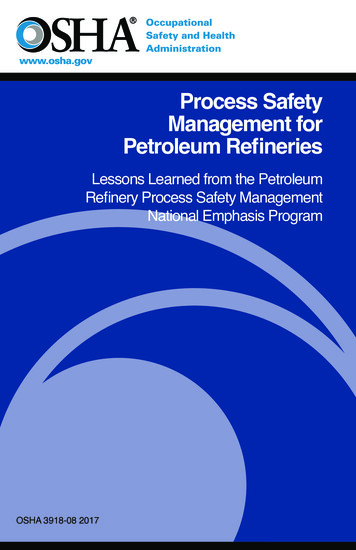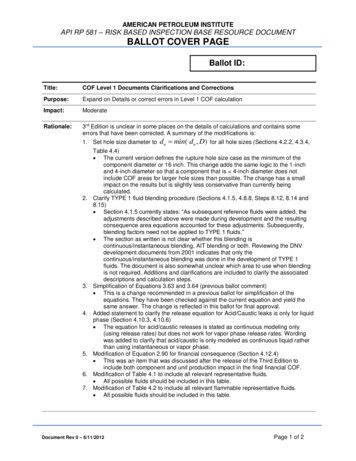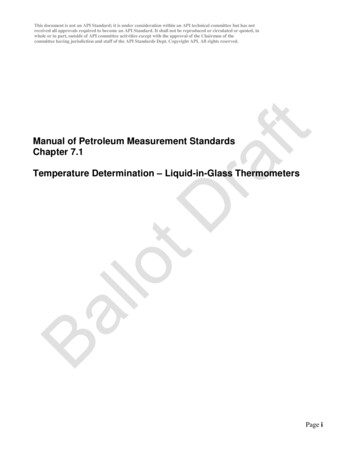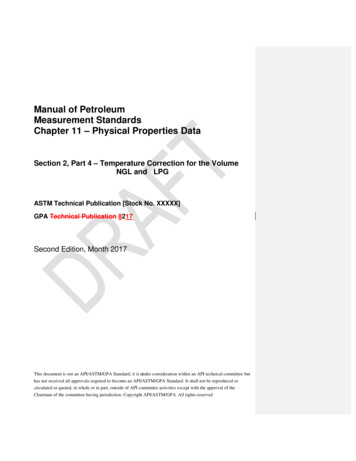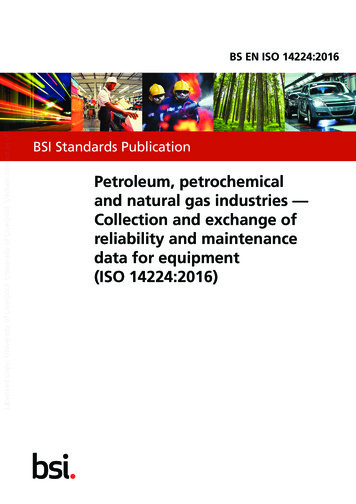
Transcription
PetroleumEngineeringHandbook
Petroleum Engineering HandbookLarry W. Lake, Editor-in-ChiefIIIIIIIVVVIVIIGeneral Engineering John R. Fanchi, EditorDrilling Engineering Robert F. Mitchell, EditorFacilities and Construction Engineering Kenneth E. Arnold, EditorProduction Operations Engineering Joe Dunn Clegg, EditorReservoir Engineering and Petrophysics Edward D. Holstein, EditorEmerging and Peripheral Technologies H.R. Warner Jr., EditorIndexes and Standards
Petroleum Engineering HandbookLarry W. Lake, Editor-in-ChiefU. of Texas at AustinVolume VIIIndexes and StandardsSociety of Petroleum Engineers
Copyright 2007 Society of Petroleum EngineersAll rights reserved. No portion of this book may be reproduced in any form or by any means, including electronic storage and retrieval systems, except by explicit, prior written permission of the publisher except forbrief passages excerpted for review and critical purposes.Printed in the United States of America.The paper used in this book meets the minimum requirements of ANSI/NSIO Z39.48-1992 (R1997). ISBNISBNISBNISBNISBNISBN978-1-55563-124-6 (print)978-1-55563-125-3 (CD)978-1-55563-134-5 (print and CD)978-1-55563-126-0 (Complete 7-Vol. Set, print)978-1-55563-127-7 (Complete 7-Vol. Set, CD)978-1-55563-135-2 (Complete 7-Vol. Set, print and CD)07 08 09 10 11 12 13 14 / 9 8 7 6 5 4 3 2 1Society of Petroleum Engineers222 Palisades Creek DriveRichardson, TX 75080-2040 393iv
ContentsMaster Author Index . . . . . . . . . . . . . . . . . . . . . . . . . . . . . . . . . . . . . . 1Master Subject Index . . . . . . . . . . . . . . . . . . . . . . . . . . . . . . . . . . . . . . 11SPE Symbols Standard . . . . . . . . . . . . . . . . . . . . . . . . . . . . . . . . . . . . . 103Overview of the SPE Symbols Standard . . . . . . . . . . . . . . . . . . . . 103Basic Symbols in Alphabetical Order . . . . . . . . . . . . . . . . . . . . . . 107Economics Symbols in Alphabetical Order . . . . . . . . . . . . . . . . . 114Symbols in Alphabetical Order. . . . . . . . . . . . . . . . . . . . . . . . . . 116Subscript Symbols in Alphabetical Order . . . . . . . . . . . . . . . . . . 133SI Metric Conversion Factors . . . . . . . . . . . . . . . . . . . . . . . . . . . . . . . 141Alphabetical List of Units . . . . . . . . . . . . . . . . . . . . . . . . . . . . . . . . 142Conversion Factors for the Vara . . . . . . . . . . . . . . . . . . . . . . . . . . 150 “Memory Jogger ” —Metric Units . . . . . . . . . . . . . . . . . . . . . . . . . 151Tables of Recommended SI Units . . . . . . . . . . . . . . . . . . . . . . . . . 153Some Additional Application Standards . . . . . . . . . . . . . . . . . . . . 169
SPE Symbols StandardOverview of the SPE Symbols StandardPrinciples of Symbols SelectionSince the original reservoir Symbols Standard was established in 1956, the principles used in the selectionof additional symbols have been as follows.1.2.3.4.5.6.7.(A) Use single letters only for the main letter symbols. This is the universal practice of the American Natl. Standards Inst. (ANSI), the Intl. Organization for Standardization (ISO), and the Intl.Union of Pure and Applied Physics (IUPAP) in more then 20 formal standards adopted by themfor letter symbols used in mathematical equations.(B) Make available single and multiple subscripts to the main letter symbols to the extent necessary for clarity. Multiple letters, such as abbreviations, are prohibited for use as the main symbol(kernel) for a quantity. A few exceptions are some traditional mathematical symbols, such as log,ln, and lim. Thus, quantities that are sometimes represented by abbreviations in textual material,tables, or graphs are required in the SPE Symbols Standard to have single-letter kernels. Examplesare gas/oil ratio (GOR), bottomhole pressure (BHP), spontaneous potential (SP), and static SP(SSP), which have the following SPE standard symbols: R, pbh, ESP, and ESSP, respectively.Adopt the letter symbols of original or prior author usage, where not in conflict with Principles 3and 4.Adopt letter symbols consistent or parallel with the existing SPE Symbols Standard, minimizingconflicts with that Standard.Where pertinent, adopt the symbols already standardized by such authorities as ANSI, ISO, orIUPAP (see Principle 1); minimize conflicts with these standards.Limit the list principally to basic quantities, avoiding symbols and subscripts for combinations,reciprocals, special conditions, etc.Use initial letters of materials, phase, processes, etc., for symbols and subscripts; they are suggestive and easily remembered.Choose symbols that can be readily handwritten, typed, and printed.Principles of Letter Symbol StandardizationRequirements for Published Quantity.1.2.3.Symbols should be standard where possible. In the use of published symbols, authors of technicalworks (including textbooks) are urged to adopt the symbols in this and other current standards andto conform to the principles stated here. An author should provide a Nomenclature list in which allsymbols are listed and defined. For work in a specialized or developing field, an author may needsymbols in addition to those already contained in standards. In such a case, the author should becareful to select simple, suggestive symbols that avoid conflict in the given field and in otherclosely related special fields. Except in this situation, the author should not introduce new symbolsor depart from currently accepted notation.Symbols should be clear in reference. One should not assign different meanings to a given symbolin such a manner as to make its interpretation in a given context ambiguous. Conflicts must beavoided. A listed alternative symbol or a modifying subscript is often available and should beadopted. Any symbol not familiar to the reading public should have its meaning defined. The unitsshould be indicated whenever necessary.Symbols should be easily identified. Because of the many numerals, letters, and signs that are similar in appearance, a writer should be careful in calling for separate symbols that in published formmight be confused by the reader. For example, many letters in the Greek alphabet (lower case and
104SPE Symbols Standard4.capital) are practically indistinguishable from English letters, and the zero is easily mistaken forthe capital O.Symbols should be economical in publication. One should try to keep the cost of publishing symbols at a minimum: no one work should use a great variety of types and special characters; handwriting of inserted symbols, in copy largely typewritten and to be reproduced in facsimile, shouldnot be excessive; and often a complicated expression appears as a component part of a given base.Instead, one may introduce, locally, a single nonconflicting letter to stand for such a complicatedcomponent. An explanatory definition should then appear in the immediate context.Secondary Symbols. Subscripts and superscripts are widely used for a variety of conventional purposes.For example, a subscript may indicate the place of a term in a sequence or matrix; a designated state, point,part, time, or system of units; the constancy of one independent physical quantity among others on which agiven quantity depends for its value; or a variable with respect to which the given quantity is a derivative.Likewise, for example, a superscript may indicate the exponent for a power, a distinguishing label, a unit,or a tensor index. The intended sense must be clear in each case. Several subscripts or superscripts, sometimes separated by commas, may be attached to a single letter. A symbol with a superscript such as prime(Ļ ) or second (ļ ) or a tensor index should be enclosed in parentheses, braces, or brackets before an exponentis attached. So far as logical clarity permits, one should avoid attaching subscripts and superscripts to subscripts and superscripts. Abbreviations, themselves standardized, may appear among subscripts. A conventional sign or abbreviation indicating the adopted unit may be attached to a letter symbol or correspondingnumeral. Reference marks, such as numbers in distinctive type, may be attached to words and abbreviations, but not to letter symbols.Multiple Subscripts —Position Order. The wide variety and complexity of subject matter covered in thepetroleum literature make it impossible to avoid use of multiple subscripts with many symbols. To makesuch usage less confusing, the following guides were used for the order of appearance of the individualletters in multiple subscripts in the symbols list. Use of the same rules is recommended when it becomesnecessary to establish a multiple-subscript notation that has not been included in this list.1.2.3.4.5.6.7.When the subscript r for “relative ” is used, it should appear first in subscript order. Examples: kroand krg.When the subscript i for “injection, ” “injected, ” or “irreducible ” is used, it should appear first insubscript order (but after r for “relative ”). Examples: Big, formation volume factor of injected gas,and cig, compressibility of injected gas.Except for Cases 1 and 2 above (and symbols kh and Lv), phase, composition, and system subscripts should generally appear first in subscript order. Examples: Bgi, initial or original gas FVF;Boi, initial or original oil FVF; CO2i, initial or original oxygen concentration; Bri, initial or originaltotal system formation volume factor; ǏsE, density of solid particles making up experimental pack;and FaF, GLp, Gwgp, and GFi.Abbreviation subscripts (such as “ext, ” “lim, ” “max, ” “min ”), when applied to a symbol alreadysubscripted, should appear last in subscript order and require that the basic symbol and its initialsubscript(s) be first enclosed in parentheses. Examples: (ia1)max and (Shr)min.Except for Case 4, numerical subscripts should appear last in subscript order. Examples: qoD3,dimensionless oil-production rate during Time Period 3; pR2, reservoir pressure at Time 2; and(ia1)max, maximum air-injection rate during Time Period 1.Except for Cases 4 and 5, subscript D for “dimensionless ” usually should appear last in subscriptorder. Examples: ptD, qoD, and (qoD3)max.Except for Cases 4 through 6, the following subscripts usually should appear last in subscriptorder; regions such as bank, burned, depleted, front, swept, and unburned (b, b, d, f, s, and u);separation, differential, and flash (sp, d, and f); and individual component identification (I orother). Examples: EbD, Rsf, and npj.Typography. When appearing as lightfaced letters of the English alphabet, letter symbols for physicalquantities and other subscripts and superscripts, whether upper case, lower case, or in small capitals, are
SPE Symbols Standard105printed in italic (slanted) type. Arabic numerals and letters of other alphabets used in mathematic expressions are normally printed in vertical type. When a special alphabet is required, boldface type is preferredover German, Gothic, or script type. It is important to select a typeface that has italic forms and clearlydistinguished upper case, lower case, and small capitals. Typefaces with serifs are recommended.Remarks. Quantity symbols may be used in mathematical expressions in any way consistent with goodmathematical usage. The product of two quantities is indicated by writing ab. The quotient may be indicated by writinga, a/b, or ab –1.bIf more than one solidus (/) is used in any algebraic term, parentheses must be inserted to remove any ambiguity. Thus, one may write (a/b)/c, or a/bc, but not a/b/c.Special Notes.1. When the mobilities involved are on opposite sides of an interface, the mobility ratio will be defined as the ratio of the displacing phase mobility to the displaced phase mobility, or the ratio ofthe upstream mobility to the downstream mobility.2. Abbreviated chemical formulas are used as subscripts for paraffin hydrocarbons: C1 for methane,C2 for ethane, C3 for propane Cn for CnH2n 2.3. Complete chemical formulas are used as subscripts for materials: CO2 for carbon dioxide, CO forcarbon monoxide, O2 for oxygen, N2 for nitrogen, etc.4. The letter R is retained for electrical resistivity in well logging usage. The symbol Ǐ is to be usedin all other cases and is that preferred by ASA.5. The letter C is retained for electrical conductivity in well logging usage. The symbol ı is to beused in all other cases and is that preferred by ASA.6. Dimensions: L length, m mass, q electrical charge, t time, T temperature, M money, andn amount of substance.7. Dimensionless numbers are criteria for geometric, kinematic, and dynamic similarity between twosystems. They are derived by one of three procedures used in methods of similarity: integral,differential, or dimensional. Examples of dimensionless numbers are Reynolds number, NRe, andPrandtl number, NPr. For a discussion of methods of similarity and dimensionless numbers, see “Methods of Similarity, ” by R.E. Schilson, JPT (August 1964) 877 –879.8.The quantity x can be modified to indicate an average or mean value by an overbar, x .Distinctions Between and Descriptions of Abbreviations, Dimensions, LetterSymbols, Reserve Symbols, Unit Abbreviations, and UnitsConfusion often arises as to the proper distinctions between abbreviations, dimensions, letter symbols,reserve symbols, unit abbreviations, and units used in science and engineering. SPE has adhered to thefollowing descriptions.Abbreviations. For use in textual matter, tables, figures, and oral discussions. An abbreviation is a letter orgroup of letters that may be used in place of the full name of a quantity, unit, or other entity. Abbreviationsare not acceptable in mathematical equations.Dimensions. Dimensions identify the physical nature or the general components of a specific physicalquantity. SPE uses seven basic dimensions: mass, length, time, temperature, electrical charge, money, andamount (m, L, t, T, q, M, and n).*Letter Symbols. For use i
Petroleum Engineering Handbook Larry W. Lake, Editor-in-Chief I General Engineering John R. Fanchi, Editor II Drilling Engineering Robert F. Mitchell, Editor III
